![]()
![]()
![]()
Use LEFT and RIGHT arrow keys to navigate between flashcards;
Use UP and DOWN arrow keys to flip the card;
H to show hint;
A reads text to speech;
25 Cards in this Set
- Front
- Back
|
How do we obtain energy from nutrients?
|
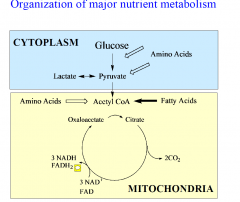
- remove the e- essentially to make ATP
|
|
|
How do we make ATP?
|
in the mitochondria using the electron chain
- also via direct breakdown of nutrients (Anerobic) |
|
|
How is heat generated?
|
- result of biochemical activity
|
|
|
What controls heat generation?
|
Hormones; such as thyroid, adrenalin... under Hypothalamic control
- skeletal muscle - brown adipose tissue - futile cycling |
|
|
How can heat generation be increased?
|
•increased ATP utilization
•reduced efficiency of ATP synthesis |
|
|
Thermogenesis (Heat Production)
2 forms |
Obligatory: associated with the resting metabolic rate (relaxed subject @ standard temperature: 23 ˚C)
Adaptive (facultative): increased metabolic rate (e.g., due to decreased temperature, increased food intake) |
|
|
Regulation of adaptive thermogenesis
|
Sensing arm: Hypothalamus (temperature and nutrient sensors)
Effector arms: Thyroid hormone Sympathetic Nervous System |
|
|
Control of thyroid hormone release
|
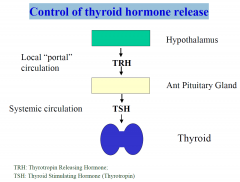
|
|
|
Thyroid hormones Chemical Structure
|
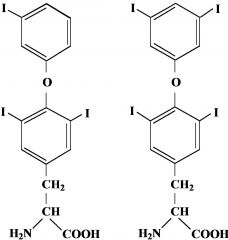
amines
- modified from tyrosine |
|
|
Sites of Adaptive Thermogenesis
|
1. Brown Adipose Tissue
- Large numbers of mitochondria (cytochromes are brown) - Mitochondria a key site of heat generation 2. Skeletal Muscle - Acute (Shivering): ATP breakdown via “futile” contractions - Prolonged: Changes in muscle fibre phenotype; enhanced mitochondrial biogenesis & SERCA (smooth ER Ca ATPas) expression 3. Futile metabolic cycles |
|
|
Location of brown adipose tissue in Adults
|
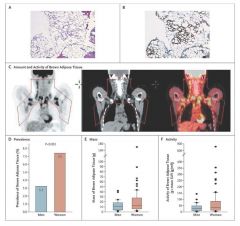
- there isnt much brown adipose tissue in adults
- MOST particularly around the heart in the mediastinum |
|
|
How is heat produced from metabolism?
|
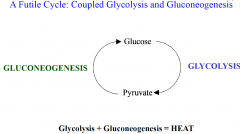
1. ATP breakdown without work
2. Coupling opposed pathways to one another (futile cycles) 3. Impaired efficiency of ATP-dependent ion transport (e.g. Ca2+ transport from Cytoplasm to SER store via SERCA) 4. Uncoupling nutrient metabolism from ATP synthesis (i.e., metabolism without energy storage) |
|
|
Futile Cycle of Glycolysis
|
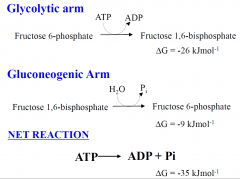
|
|
|
Heat Production from skeletal muscle cells
|
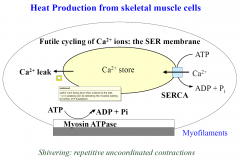
1. futile cycling of Ca2+
2. Shivering |
|
|
Another example of heat generation from ion transport
Na |
•
Na+ leak across plasma membrane activates Na+/K+-ATPase to pump them out again • Net effect is ATP break down and heat generation • Thyroid hormone may increase membrane Na+ permeability |
|
|
How is ATP synthesized in mitochondria?
|
- electron transport chain then driving complex V via a proton pump to make ATP
|
|
|
How can mitochondria act as sites of heat production?
|
- UCP
- reduced efficacy - Complex II rather than I shunting |
|
|
What is the origin of the energy value of food?
|
A. Its electrons.
Glycolysis, Fatty Acid Oxidation, Citric Acid Cycle: Electrons stripped from major nutrients (carbohydrate, fat, protein) Mitochondrial electron carriers loaded up: NADH and FADH2 |
|
|
How do NADH and FADH2 promote:
ATP synthesis? OR HEAT? |
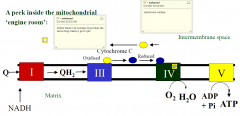
Electrons are transferred between complexes Complex V is an ATP synthase when electrons flow Electron flow is coupled to ATP synthesis
|
|
|
How is electron flow coupled to ATP synthesis?
|

1. Electron flow is coupled to proton pumping
2. Complexes I, III and IV are electron-driven proton pumps 3. Protons accumulate in intermembrane space (IMS); pH drops to 3 4. H+ flux back through complex V drives ATP synthesis |
|
|
How is heat generated from mitochondria?
|
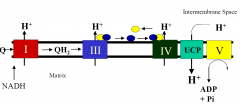
Oxidative phosphorylation is uncoupled
UNCOUPLING PROTEIN (UCP) provides alternative route for H+ re-entry Heat arises from futile recycling of protons |
|
|
UCP
|
UCP-1 in brown adipose tissue
UCP-2 is widely expressed and under thyroid control UCP-3 expressed in skeletal muscle and under thyroid control |
|
|
How is heat production regulated by thyroid hormone?
|
1. Increased expression of uncoupling proteins (e.g., UCP-2; UCP-3*)
2. Reduced efficiency of mitochondrial proton pumping 3. Feeding electrons via complex II rather than complex I (less proton pumping)** (Glycerol 3-phosphate shuttle) 4. Thyroid hormone promotes SERCA expression and impairs its efficiency 5. Sympathetic nervous system effects: Enhanced β2-adrenergic receptor expression in muscle |
|
|
Roles of other hormones in control of heat production
|
1. Adrenalin: stimulates hepatic gluconeogenesis; induces vasodilatation in skeletal muscle; promotes conversion of T4 to T3 (deiodinase-2 expression)
2. Leptin: promotes activation of the sympathetic nervous system 3. Insulin: Cold exposure increases glucose uptake and metabolism (especially in fat cells) 4. Glucagon: Stimulates gluconeogenesis |
|
|
Measurement of Heat Production
|
Direct calorimetry: expensive and time consuming (heat porduction is slow)
1. Indirect Calorimery: measure O2 cunsumption (depletion of O2 in expired air) 2. Doubly-labelled Water*: compare water and CO2 excretion |

